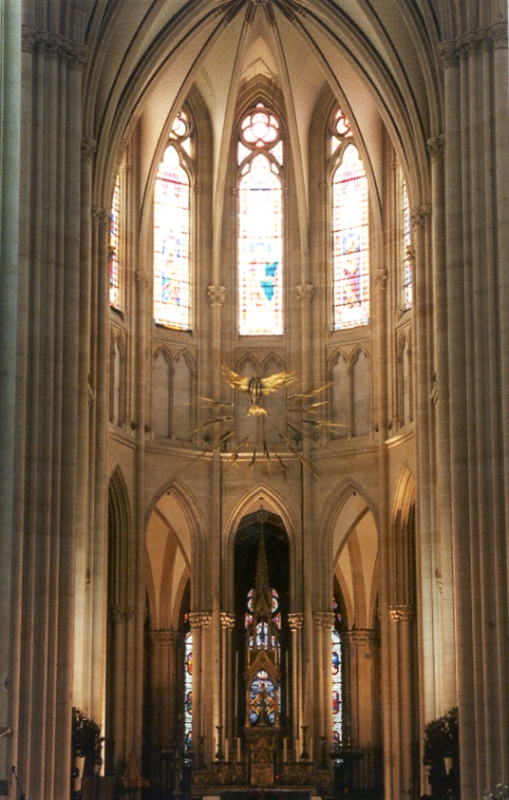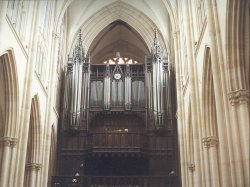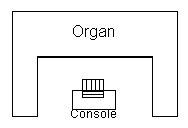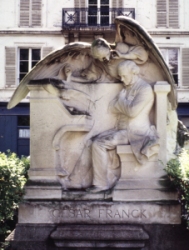The Church
The church of Ste. Clotilde is dedicated to Clotilde, the daughter of the fifth century Burgundian king Chilperic. She was made the wife of Clovis, king of the Franks, and she was able to persuade him to convert to Christianity in 496 AD. Thereafter, France was a Christian kingdom.
 The church of Ste. Clotilde was begun in 1846 in imitation of the gothic style that characterizes so many churches of Paris. It was designed by Viollet le Duc, who was responsible for many restorations throughout France in the nineteenth century. As you can see in the photograph to the left, the façade of the building has many characteristics that we associate with Gothic architecture. The spires are quite tall, with smaller, more decorative stonework at the higher levels, and the arches have the typical pointed shape. Although it is partially obscured in this particular photograph, there is a rose window over the porch, and the arches on either side of that echo the larger shapes below. The church of Ste. Clotilde was begun in 1846 in imitation of the gothic style that characterizes so many churches of Paris. It was designed by Viollet le Duc, who was responsible for many restorations throughout France in the nineteenth century. As you can see in the photograph to the left, the façade of the building has many characteristics that we associate with Gothic architecture. The spires are quite tall, with smaller, more decorative stonework at the higher levels, and the arches have the typical pointed shape. Although it is partially obscured in this particular photograph, there is a rose window over the porch, and the arches on either side of that echo the larger shapes below.
 The first impression you have when you enter the building is one of great height, because the general effect of a Gothic building has been emphasized in the proportions of this newer church. The exaggeration of identifying characteristics is, of course, common in many "revival" styles of both architecture and music, so Ste. Clotilde is not unusual in that respect. The photograph to the right shows the arches and stonework above the altar, where the vertical extension of the design is most evident. The first impression you have when you enter the building is one of great height, because the general effect of a Gothic building has been emphasized in the proportions of this newer church. The exaggeration of identifying characteristics is, of course, common in many "revival" styles of both architecture and music, so Ste. Clotilde is not unusual in that respect. The photograph to the right shows the arches and stonework above the altar, where the vertical extension of the design is most evident.
 The exaggerated height of the nave also allows the organ to be placed higher than one might expect. If you continue into the church until you reach the mid-point of the nave and then turn around, you will see the organ in the second gallery at the west end of the church. This is one of the highest organ galleries in all of Paris. You will also see another unusual feature in that the Choir and accompanying choir organ are in the first gallery, below the Grand orgue, rather than in the Chancel. The exaggerated height of the nave also allows the organ to be placed higher than one might expect. If you continue into the church until you reach the mid-point of the nave and then turn around, you will see the organ in the second gallery at the west end of the church. This is one of the highest organ galleries in all of Paris. You will also see another unusual feature in that the Choir and accompanying choir organ are in the first gallery, below the Grand orgue, rather than in the Chancel.
Original Disposition of the Organ
 When the building was designed, little thought was given to placing an organ in it, and at one point it was assumed that an organ would be impossible in a rear gallery.215 Eventually the problem of space was solved through the addtion of a steel framework to support the gallery. This structure allowed the organ to be built on the upper gallery level, with space for the choir on the first level. Further accommodation by Cavaillé-Coll to the unusual space requirements can be seen in the extension of the side towers forward to the front of the gallery itself. The console is, in effect, enclosed on three sides by the organ, as shown in the diagram. The forward projections house the Grand orgue and Positif, not the pedal stops as one would expect in a German instrument with a similar façade. When the building was designed, little thought was given to placing an organ in it, and at one point it was assumed that an organ would be impossible in a rear gallery.215 Eventually the problem of space was solved through the addtion of a steel framework to support the gallery. This structure allowed the organ to be built on the upper gallery level, with space for the choir on the first level. Further accommodation by Cavaillé-Coll to the unusual space requirements can be seen in the extension of the side towers forward to the front of the gallery itself. The console is, in effect, enclosed on three sides by the organ, as shown in the diagram. The forward projections house the Grand orgue and Positif, not the pedal stops as one would expect in a German instrument with a similar façade.
You can find another important characteristic of Cavaillé-Coll's instrument in the orientation of the console itself. The console is detached from the case and turned around so that the organist faces the altar. Detached reversed consoles had been built before the nineteenth century, but they were rare because the extra turns in the tracker runs made it difficult to prevent the action from becoming too heavy. With the use of Barker machines, this objection to reversed consoles was no longer a factor, and we find many of Cavaillé-Coll's instruments have their consoles in the position shown here.
After the building was begun and a contract with Cavaillé-Coll signed in 1849, construction of the steel frame, organ gallery, and organ case was begun by the contractor for the building. During the same period, Cavaillé-Coll was building the organ. After delays and changes in the original design, some of them at the request of César Franck, the organ was completely installed and dedicated in December of 1859. At the time of this recital, the organ had the following disposition.216
When you read this stoplist there are several characteristics you should notice, all of them typical of the instruments built by Cavaillé-Coll in the middle of the century.
- First of all, the Grand orgue and Positif contain the basic stops of the traditional French divisions. The choruses are based on Montres of 16' and 8' pitches espectively, with the Plain jeu taking the place of both Fourniture and Cymbale found on older instruments. With the Clarinette replacing the Cromorne, even the reeds continue the tradition of French organ building that was over 150 years old in the middle of the nineteenth century. What distinguishes these two divisions from their predecessors is the omission of third-sounding stops, tierces and cornets, and the addition of strings and harmonic flutes.
- Similarly, the Pédale contains only those stops which had become common on organs of the late eighteenth century, such as those built by Clicquot. Only the 32' Soubasse and the second 16' reed (the Basson) are new in comparison to late Classical organs.
- The Récit has a stoplist that is almost entirely new when compared to older instruments. Of the stops included here, only the Hautbois would have been found on a French classical instrument. The usual Cornet is absent, as is the case with the Grand orgue. In addition to being enclosed -- a new feature in French instruments -- the division now is characterized by harmonic flutes and strings.
- Finally, the presence of two "beating stops," the Unda maris of the Positif and the Voix céleste of the Récit, constitutes a new sound in French organs, one whose importance is sometimes exaggerated through overuse by American organists, but whose presence is important here as a new sound in French instruments.
Details of this stoplist were the subject of much discussion for the second half of the twentieth century. Specifically, there are some people who accept the stoplist as given above, in which there is no tirasse for the Récit. Others insist that it was there originally, but never used by Franck in his compositions written for this instrument. Most evidence indicates that there was no such coupler, a position supported by examination of the original console, which became the property of Flor Peeters of the Belgian Conservatoire. As you will see in the next section, replacement of the original console in 1933, at the time the organ was first enlarged, meant that the original configuration of the instrument was no longer available for direct study.
The Organ under Tournemire and Langlais
In 1933 Charles Tournemire, then titulaire of Ste. Clotilde, had some modifications made to the organ. These changes, carried out by the Beuchet-Debierre firm, affected not only the stoplist, but also the mechanics of the organ. A new console was built that incorporated several new features, especially couplers and appels. The original action was retained, however, including the Barker machines. In summary, these changes were made to the organ at this time.
| Grand orgue |
- A Cornet V was added.
- The 4' Octave was transformed into a 4' Flûte .
|
| Positif |
- The Unda maris was retuned and transformed into a Salicional.
- The Flûte octaviante was transformed into a 4' Flûte.
- The Clarinette was moved to the Récit.
- Two stops were added:
- A 1 3/5' Tierce
- A 1' Piccolo
|
| Récit |
- The 4' Flûte octaviante was transformed into a 4' Flûte.
- Six stops were added:
- A 16' Quintaton
- A 2 2/3' Nasard
- A 1 3/5' Tierce
- A Plein Jeu IV
- A 16' Bombarde
- The 8' Clarinette from the Positif
|
| Pédale |
- The 8' Basse became an 8' Flûte.
- The 4' Octave became a 4' Flûte.
- Two stops were added:
- A 16' Bourdon
- A Quinte
|
| The 14 Pédales de combinaison of the original console were extended to 26, including super-octave couplers, sub-octave couplers, and both appel and renvoi levers for mixtures. |
| The Swell box was enlarged considerably to accommodate the added stops. |
| The original action and Barker machines were retained. |
The resulting stoplist of the Ste. Clotilde organ is that given below. It is useful to know the instrument as it existed at this time, because this is the organ that was played both by Tournemire in his later years and by Langlais for the first thirty years of his tenure as organist there. Much of Langlais' music that has become part of the standard repertoire originated during this time. New stops, those created from existing original stops as well as brand new ones, are listed in bold type.
Grand Orgue
C-f''' |
|
Positif
C-f''' |
|
Récit
C-f''' |
|
Pédale
C-d' |
|
| Montre |
|
16 |
|
Bourdon |
|
16 |
|
Quintaton |
|
16 |
|
Soubasse |
|
32 |
|
| Bourdon |
|
16 |
|
Montre |
|
8 |
|
Flûte harmonique |
|
8 |
|
Contrebasse |
|
16 |
|
| Montre |
|
8 |
|
Flûte harmonique |
|
8 |
|
Bourdon |
|
8 |
|
Bourdon |
|
16
|
|
| Flúte harmonique |
|
8 |
|
Bourdon |
|
8 |
|
Viole de gambe |
|
8 |
|
Quinte |
|
10 2/3
|
|
| Bourdon |
|
8 |
|
Viole de gambe |
|
8 |
|
Voix céleste |
|
8 |
|
Flûte |
|
8 |
|
| Viole de gambe |
|
8 |
|
Salicional |
|
8 |
|
*Flûte |
|
4 |
|
Flûte |
|
4 |
|
| Prestant |
|
4 |
|
Prestant |
|
4 |
|
*Nasard |
|
2 2/3 |
|
*Bombarde |
|
16 |
|
| *Flûte |
|
4 |
|
*Flûte |
|
4 |
|
*Octavin |
|
2 |
|
*Basson |
|
16 |
|
| *Quinte |
|
2 2/3 |
|
*Quinte |
|
2 2/3 |
|
*Tierce |
|
1 3/5 |
|
*Trompette |
|
8
|
| *Doublette |
|
2 |
|
*Doublette |
|
2 |
|
*Plein-Jeu IV |
|
|
|
*Clairon |
|
4
|
| *Cornet V |
|
|
|
*Tierce |
|
1 3/5 |
|
*Bombarde |
|
16
|
| *Plein-jeu VII |
|
|
|
*Piccolo |
|
1 |
|
*Trompette |
|
8
|
| *Bombarde |
|
16 |
|
*Plein jeu harmonique III-VI |
|
|
|
Basson-Hautbois |
|
8
|
| *Trompette |
|
8 |
|
*Trompette |
|
8 |
|
Clarinette |
|
8
|
| *Clairon |
|
4
|
|
*Clairon |
|
4
|
|
Voix humaine |
|
8
|
|
|
|
|
|
|
|
|
*Clairon |
|
4
|
Disposition after 1962
Several factors contributed to the next round in changes to the organ of Ste. Clotilde. In part because of age, in part because of modifications to the chests in earlier expansions, and in part because of inadeqate maintenance, the original Barker machines were no longer dependable. Although repairs to the machines might have been possible, it was a general tendency of the time to modernize mechanics of all sorts, including organ consoles. Replacing an aging machine with a new one was an attractive alternative. Finally, the desire to add more stops to the organ was strong enough to put into effect another rebuild of the Ste. Clotilde organ in 1962.
During this rebuild, electric pull-downs were added to the chests, a new console (complete with pistons and a crescendo pedal) was provided, and several more stops were added at the request of titulaire Jean Langlais. This table summarizes the changes to the stoplist:
| Grand orgue |
Unchanged |
| Positif |
Viole de gambe replaced by a 1 1/3' Larigot |
| Récit |
Two new stops:
- 4' Principal italien
- 2' Clairon
|
| Pédale |
- Quinte replaced by an 8' Bourdon
- Two stops added:
- A 4' Prestant
- A 2' Doublette
|
Couplers/Other
Playing Aids |
- Inter-manual couplers at 16', 8' and 4' pitches
- Tirasses for each manual division
- Appel d'anches for each division (manual and pedals)
- Appel de mixtures for each manual division
|
In the stoplist for this period, you will notice that the asterisks seen in the stoplists above are no longer present. Even though the old chests were reused, the new console, with an adjustable combination action, made the older ventil controls obsolete. Both the laye des fonds and the laye des anches were winded at all times. Changes in registration by means similar to those provided by the older ventils were still possible, however. In fact, as you can see from the controls listed above, the new console actually provided another level of subtlety in changing registrations according to the Cavaillé-Coll ventil method. Now there were two controls (appel d'anche and appel de mixture) where before only one control affected both reeds and upperwork. With the possibilities offered by electric action and the new console, the organist could choose to use thumb pistons and toe studs like the ones found on American and English organs, or he could use the Appels to emulate the older ventil levers.
Here's the complete stoplist of the 1962 rebuild:
Grand Orgue
C-f''' |
|
Positif
C-f''' |
|
Récit
C-f''' |
|
Pédale
C-d' |
|
| Montre |
|
16 |
|
Bourdon |
|
16 |
|
Quintaton |
|
16 |
|
Soubasse |
|
32 |
|
| Bourdon |
|
16 |
|
Montre |
|
8 |
|
Flûte harmonique |
|
8 |
|
Contrebasse |
|
16 |
|
| Montre |
|
8 |
|
Flûte harmonique |
|
8 |
|
Bourdon |
|
8 |
|
Bourdon |
|
16
|
|
| Flúte harmonique |
|
8 |
|
Bourdon |
|
8 |
|
Viole de gambe |
|
8 |
|
Quinte |
|
10 2/3
|
|
| Bourdon |
|
8 |
|
Salicional |
|
8 |
|
Voix céleste |
|
8 |
|
Flûte |
|
8 |
|
| Viole de gambe |
|
8 |
|
Prestant |
|
4 |
|
Principal italien |
|
4 |
|
Prestant |
|
4 |
|
| Prestant |
|
4 |
|
Flûte |
|
4 |
|
Flûte |
|
4 |
|
Flûte |
|
4 |
|
| Flûte |
|
4 |
|
Quinte |
|
2 2/3 |
|
Nasard |
|
2 2/3 |
|
Doublette |
|
2 |
|
| Quinte |
|
2 2/3 |
|
Doublette |
|
2 |
|
Octavin |
|
2 |
|
Bombarde |
|
16
|
| Doublette |
|
2 |
|
Tierce |
|
1 3/5 |
|
Tierce |
|
1 3/5 |
|
Basson |
|
8
|
| Cornet V |
|
|
|
Larigot |
|
1 1/3 |
|
Plein-Jeu IV |
|
|
|
Trompette |
|
8
|
| Plein-jeu VII |
|
|
|
Piccolo |
|
1 |
|
Bombarde |
|
16
|
|
Clairon |
|
4
|
| Bombarde |
|
16 |
|
Plein jeu harmonique III-VI |
|
|
|
Trompette |
|
8
|
| Trompette |
|
8 |
|
Trompette |
|
8 |
|
Basson-Hautbois |
|
8
|
| Clairon |
|
4
|
|
Clairon |
|
4
|
|
Clarinette |
|
8
|
|
|
|
|
|
|
|
|
Voix humaine |
|
8
|
|
|
|
|
|
|
|
|
|
|
|
|
|
Clairon |
|
4
|
|
|
|
|
|
|
|
|
|
|
|
|
|
Clairon |
|
2
|
Recent Changes
As is often the case with an instrument that serves an ever-changing community and parish, the organ of Ste. Clotilde has not rested unchanged since 1962.
- In 1983, Jacques Barberis completed a cleaning and renewal of the organ, working under the direction of Jean Langlais. The only effect of this work on the stoplist of the organ was the return of the Clarinette to the Positif.
- Similarly, the console has been modified again; it now has a solid-state stop action with multiple channels of memory and an adjustable crescendo pedal.
At some point in the past, either during the modifications of 1933 or when the action was electrified in 1962, the wind pressure of the Positif was lowered. The result was a change in the balance between the Grand orgue and the Positif from that known by Franck and Tournemire. No doubt further changes and modifications to the instrument will be made, and discussions of the future of the organ are underway now. The table below summarizes the changes in disposition of this well-known and historically important instrument.
| Year |
|
Event |
| 1859 |
|
Organ installed. 46 stops. |
| 1933 |
|
Organ enlarged under the direction of Charles Tournemire, with new console by Beuchet-Debierre. 56 stops. |
| 1962 |
|
Organ enlarged further under the direction of Jean Langlais. The action was electrified, so the original Barker machines were discarded. A new console was provided by Beuchet-Debierre. 60 stops. |
| 1983 |
|
Restoration by Jacques Barberis under the direction of Jean Langlais. |
|


 The church of Ste. Clotilde was begun in 1846 in imitation of the gothic style that characterizes so many churches of Paris. It was designed by Viollet le Duc, who was responsible for many restorations throughout France in the nineteenth century. As you can see in the photograph to the left, the façade of the building has many characteristics that we associate with Gothic architecture. The spires are quite tall, with smaller, more decorative stonework at the higher levels, and the arches have the typical pointed shape. Although it is partially obscured in this particular photograph, there is a rose window over the porch, and the arches on either side of that echo the larger shapes below.
The church of Ste. Clotilde was begun in 1846 in imitation of the gothic style that characterizes so many churches of Paris. It was designed by Viollet le Duc, who was responsible for many restorations throughout France in the nineteenth century. As you can see in the photograph to the left, the façade of the building has many characteristics that we associate with Gothic architecture. The spires are quite tall, with smaller, more decorative stonework at the higher levels, and the arches have the typical pointed shape. Although it is partially obscured in this particular photograph, there is a rose window over the porch, and the arches on either side of that echo the larger shapes below. The first impression you have when you enter the building is one of great height, because the general effect of a Gothic building has been emphasized in the proportions of this newer church. The exaggeration of identifying characteristics is, of course, common in many "revival" styles of both architecture and music, so Ste. Clotilde is not unusual in that respect. The photograph to the right shows the arches and stonework above the altar, where the vertical extension of the design is most evident.
The first impression you have when you enter the building is one of great height, because the general effect of a Gothic building has been emphasized in the proportions of this newer church. The exaggeration of identifying characteristics is, of course, common in many "revival" styles of both architecture and music, so Ste. Clotilde is not unusual in that respect. The photograph to the right shows the arches and stonework above the altar, where the vertical extension of the design is most evident. The exaggerated height of the nave also allows the organ to be placed higher than one might expect. If you continue into the church until you reach the mid-point of the nave and then turn around, you will see the organ in the second gallery at the west end of the church. This is one of the highest organ galleries in all of Paris. You will also see another unusual feature in that the Choir and accompanying choir organ are in the first gallery, below the Grand orgue, rather than in the Chancel.
The exaggerated height of the nave also allows the organ to be placed higher than one might expect. If you continue into the church until you reach the mid-point of the nave and then turn around, you will see the organ in the second gallery at the west end of the church. This is one of the highest organ galleries in all of Paris. You will also see another unusual feature in that the Choir and accompanying choir organ are in the first gallery, below the Grand orgue, rather than in the Chancel. When the building was designed, little thought was given to placing an organ in it, and at one point it was assumed that an organ would be impossible in a rear gallery.
When the building was designed, little thought was given to placing an organ in it, and at one point it was assumed that an organ would be impossible in a rear gallery.